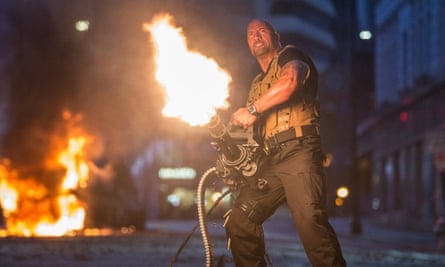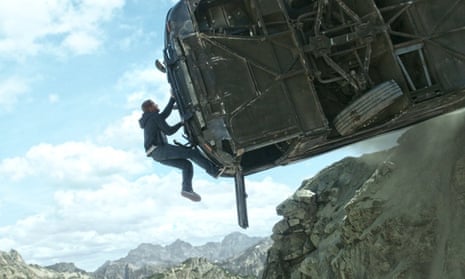The winner
Far from assured when Furious 7 was on the starting grid two weekends ago, $1bn global box office for Universal’s delayed tentpole now looks all sewn up – which will make it the first film through that gate in 2015. A $59.6m second frame for Vin Diesel and co in the US means a 59% drop – the outer edge of what’s expected for big-opening blockbusters – but the studio barely will have blinked with China and Russia dropping into the race this week. The latter, historically F&F-crazy, delivered a $15.9m opening that is a four-day record for the country; China, opening on Sunday, a $68.8m first day that is also unprecedented both financially and attendance-wise, beating Furious 6’s entire 2013 run in one fell swoop.
So director James Wan, new to the franchise, finds himself behind the wheel of the most successful instalment after just 10 days, topping number six’s $788.7m. The Paul Walker factor has undoubtedly played a part in Furious 7’s incredible surge, but there’s a longer game here: the culmination of the expansive rebuild of the series since part four, taking it away from its genre-movie origins and bolting on the beefed-up action sequences, power-play casting and international locations befitting of the global-era blockbuster. There’s a simplicity to old-fashioned automobile chaos understandable from London to Lombok, plus the series’ growing reliance on CGI keeps younger audiences on-side. It’s also tempting to pinpoint F&F’s endearingly hokey emphasis on family values for how strongly it continues to play in more traditionalist climes outside the west.
Since Fast Five, the franchise has commanded 65+% overseas audiences (high for live-action), but it is Latin America that increasingly looks like at the heart of the F&F family. Much has been made of the series’ equal-opportunities policy on race and, with Michelle Rodriguez a fixture of the series, plus plenty of Spanish-speaking settings, this has played well with American Hispanics: they made up 37% of the opening-weekend audience in North American (and 75% overall were non-white). But Furious 7 makes clear the kind of traction the series has built up in central and South America, too. Mexico ($20.8m) opened higher than the UK ($19m), and is still – at $39.7m cumulative – edging it as the second biggest market behind China; of the 26 countries where Furious 7 was the highest opener of all time, 12 were Latin American. Never mind all the incoming petrolhead knockoffs (a sequel to 2014’s Need for Speed has apparently now been greenlighted) – how about, post-F&F, a greater acceptance of the serious financial benefits of a diverse casting policy?

On $803.2m as the weekend wound up, Furious 7 should screech past $1bn very soon. That will be only Universal’s second ten-digiter ever (Jurassic Park is the other), putting it in pole position among the studios for 2015 after Fifty Shades of Grey; a weird flip-flop after 2014 saw the studio manage its most profitable year ever with no traditional blockbuster in sight. The speculation now is how much more Furious 7 has left in the tank before Avengers: Age of Ultron clanks in on the penultimate April weekend; if the US holds well next time, and Japan kicks in strongly on 17 April, some people believe it could go as high as no 4 on the worldwide all-time chart, unseating the final Harry Potter. Who’d have put money on that happening when the first film came out in 2001?
Sleepless in Shanghai
We saw a few weeks ago how television has become a fertile picking ground for Chinese cinema, with reality-TV adaptations Running Man and Dad, Where Are We Going 2? scoring strongly in February. New romcom Let’s Get Married, focusing on the conjugal complications of four different couples, is the latest off the small-screen production line, placing ninth globally this week. But it’s also part of a bigger trend, a local resurgence in romcoms over the last five years that stands in total contrast to how discredited and moribund the genre is in the States. Note the jobs of the four main protagonists: bridal boutique owner, violinist, airport security official, businesswomen. It’s this affluent, middle-class constituency - and its anxieties about balancing a love life with professional aspirations - that seems to be driving the romcom boom in the fast-urbanising country. That was the milieu for the Tiny Times series that has taken $213.8m so far over there, 2013’s Sleepless in Seattle homage Finding Mr Right (which took $84.4m), as well as a torrent of other gushy practitioners over the last half-decade. Let’s Get Married, the trailer packed full of ravishing snapshots of foreign tourist spots, is very aware of the upwardly mobile set it needs to pull in – and the four-for-the-price-of-one structure seems to be another selling point. Up to $42.9m in its second week, it’s climbing into the middle range that American romcoms used to comfortably nestle in on a regular basis; rarely blockbuster-big, but glossy repackagings of film-goers’ lives that connect on a dependable basis.
The Sparks finishing school

On the subject of dependable slush, master of the backlit romance Nicholas Sparks was back this weekend, with The Longest Ride cantering up as the 10th adaptation of his bestsellers since 1999’s Message in a Bottle. Intertwining the story of a North Carolina rodeo bull-rider’s new fling with a wartime courtship in flashback, it opened at $13m Stateside – just ahead of cult Ryan Gosling weepie The Notebook and squarely in the middle of the scale for a Sparks adaptation. Not bad considering the film’s total lack of star involvement, and a certain kind of fingers-down-throat irony beginning to attach itself to the author’s work after so much recent exposure. I say “lack of star involvement”, but The Longest Ride does come with gilded lineage in the shape of 29-year-old lead Scott Eastwood, who will be hoping that the film starts to push his career Clint-wards.
What is striking alongside the consistency of the Sparks brand (all but 2002’s A Walk to Remember and last year’s The Best of Me have taken $80m+ worldwide) is the procession of young male talent who’ve used these adaptations to broaden their audience on their way up. All with budgets of the $20-30m order, these films have been cut-price alternatives on the old-school romantic epic allowing the likes of Gosling, Channing Tatum (2010, Dear John), Liam Hemsworth (2010, The Last Song), Zac Efron (2012, The Lucky One), James Marsden (2014, The Best of Me) and now Eastwood Jr to lodge themselves, via female audiences, deeper in the mainstream.
The rest of the world
Paddington gave Peru a rare nudge into the box-office spotlight at the end of last year. So it’s good to see the country back in the world rankings again so soon, at No 13, with Asu Mare 2 – a sequel to the highest-grossing local film for 2013, a spin-off of comedian Carlos Alcántara’s one-man autobiographical TV standup show. After lampooning his own childhood in the original, he gets on to his early love life and early artistic struggles in this one – a boost for a box-office market that is still small (worth $131.5m in 2013) but steadily growing in line with South America as a whole. In France, another local-boy comic favorite, Jamel Debbouze, fell just outside the global top 10 with a $3.5m take for an unusual choice of directorial debut: Pourquoi J’ai Pas Mangé Mon Père?, an animated romp about the exiled son of a monkey king that looks somewhere between Ice Age and Year One. Finally, Wolf Warriors, Wu Jing’s action thriller about a special-forces soldier forced to go rogue – that old chestnut – held fairly solidly in its second week for the runner’s-up spot in China and fourth place globally.
The future
One more weekend before The Avengers sequel stomps into town and rearranges the all-time box-office chart – just enough time for Tom Hardy, Gary Oldman, Paddy Considine to put on their best slav-face (or Russian accents, at least) as Soviet-era child-murder thriller Child 44 opens in 20, predominantly European markets. Meanwhile, Liam Neeson’s latest geri-action nugget, Run All Night, with Russia, Australia and Mexico among its 20-or-so openings, is looking for a quick international top-up to a wan-looking $47.1m haul. Chinese’s biggest female box-office draw Fan Bingbing, who you might have seen in the local cut of Iron Man 3 and X-Men: Days of Future Past, adds to the native romcom boom with Ever Since We Love. And fellow filmic traveller Emraan Hashmi – who recently starred for Oscar-winner Danis Tanović in the interestingly-looking pharmaceutical expose Tigers – goes for the mainstream jugular in India with Mr X. He follows in the disembodied footsteps of Claude Rains, Chevy Chase and Kevin Bacon, by playing a man with the power of invisibility, and the temptations whereof. Developed by Fox Star India, this – with oddly familiar steel-blue ”X” livery stamped all over the trailer – feels like a sly attempt to seed the western-superhero bug in Bollywood audiences.
Top 10 global box office, 10-12 April
- Furious 7, $258.3m from 64 territories. $803.2m cumulative – 68.7% international; 31.3% US
- Home, $34.2m from 68 territories. $242.3m cum – 46.5% int; 53.5% US
- Cinderella, $19.8m from 55 territories. $436.8m cum – 58.6% int; 41.4% US
- Wolf Warriors, $18m from 1 territory. $68.5m cum – 100% int
- (New) The Longest Ride, $16m from 29 territories – 19% int; 81% US
- The Divergent Series: Insurgent, $14.8m from 84 territories. $250.1m cum – 54.1% int; 45.9% US
- Kingsman: The Secret Service, $10.3m from 18 territories. $392m cum – 68.2% int; 31.8% US
- Get Hard, $10m from 14 territories. $84.6m cum – 15.8% int; 84.2% US
- Let’s Get Married, $8.6m from 4 territories. $42.9m cum – 99.2% int; 0.8% US
- (New) Woman in Gold, $7.3m from 5 territories. $10.7m cum – 13.1% int; 86.9% US

Comments (…)
Sign in or create your Guardian account to join the discussion